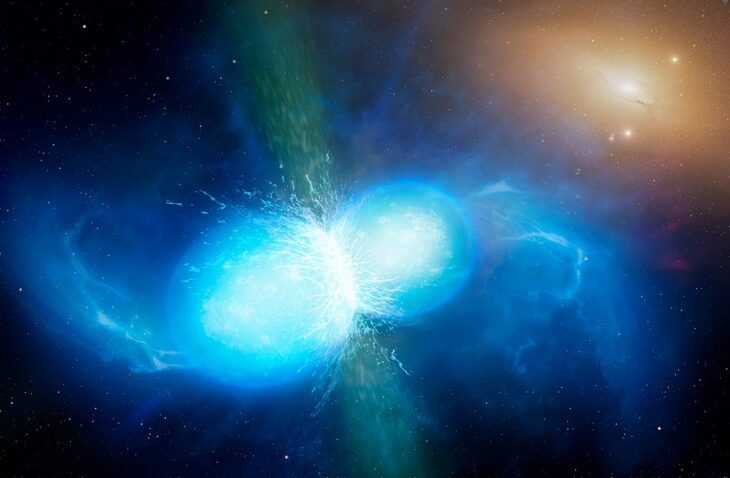Since the 1920s, when Edwin Hubble discovered that the universe is expanding, astrophysicists have asked the question, “Where does stuff come from?” In The Big Bang Theory, the possible explanation not the television show, astrophysicists propose an explosive beginning for the universe as a single hot, dense point that expanded and cooled as it transformed from pure energy to solid matter. But that origin story ends with only the 2 smallest elements: hydrogen and helium. Since not everything in the universe is made of those 2 elements, scientists are asking a new question, “Where does the other stuff come from?”
The arrival of nuclear physics in the early 20th century gave astronomers their first big clue. Researchers studying stars pointed out that they are very bright, which means they need a big source of energy to produce that much light. Nuclear physicists, including Albert Einstein and his famous E = mc2 equation, showed that one of the most powerful energy sources in the universe is smashing small atoms together to make bigger ones, that is, nuclear fusion. And that’s exactly what stars do in a hot, dense region at their center, called their core. But this process in stars has a limit – specifically iron, number 26 out of 92 naturally-occurring elements. Stars smash elements together to produce energy, but all elements bigger than iron require more energy to be created than they release. So, elements heavier than iron, like gold and uranium, are still unaccounted for.
Researchers found their next clue from huge, bright star explosions in the night sky, called supernovae. They found that massive stars more than 10 times the size of the Sun burn through their store of elements to fuse quickly. These stars run out of energy not only to shine but to hold themselves together, causing an explosion where their outer layers of elements fly off in every direction, the supernova. For decades astrophysicists thought heavy elements were made in this chaotic mix of light elements and free energy. However, when they carefully observed supernovae they found that the explosions produced fewer heavy elements than needed to explain their abundance in the universe.
Astrophysicists got their final clue in 2017 when they detected the first binary neutron star (BNS) merger by the Laser Interferometer Gravitational-wave Observatory or LIGO. The last stage in the life cycle of massive stars between 10 and 25 times as large as the Sun is a neutron star. In this stage, the star’s core collapses, squeezing the electrons and protons in its atoms so close together that they merge into neutrons. Two neutron stars orbiting each other can smash together and spray debris out into the surrounding galaxy. Researchers propose this event could provide the necessary energy and material to fuse heavy elements together into the heaviest naturally occurring elements.
Researchers at Peking University and Guangxi University wanted to test whether BNS mergers could produce elements heavier than iron. These events are exceedingly rare, happening only a few dozen times per year in the entire Galaxy, so they couldn’t point a telescope out into space and hope to get lucky. Instead, they simulated BNS mergers using advanced nuclear physics software.
The researchers gave the simulation certain starting conditions, including what atoms were available in the stars at the start of the collision, the rate of nuclear reactions and decays, how many electrons were in the mix, and how big the colliding neutron stars were. Then they used a mathematical description of how temperature, volume, and pressure are related for a substance, called an equation of state, to simulate the effects of the collision and calculate what elements are formed and ejected into space.
They found that these BNS mergers could produce a tremendous amount of extremely heavy elements, in the range of 300 to 30,000 times the mass of the Sun, which is somewhere between 10 and 1000 times that produced by a supernova. The team suggested this result could explain the abundance of heavy elements observed in the Galaxy even after taking into account losses from other cosmic effects, like the galactic wind. However, they acknowledged that their results cannot explain the abundance of all heavy elements, specifically those at the lower end of their study’s atomic mass range. They explained these elements are likely still made in the center of collapsing stars, but suggested future researchers test this hypothesis further.


